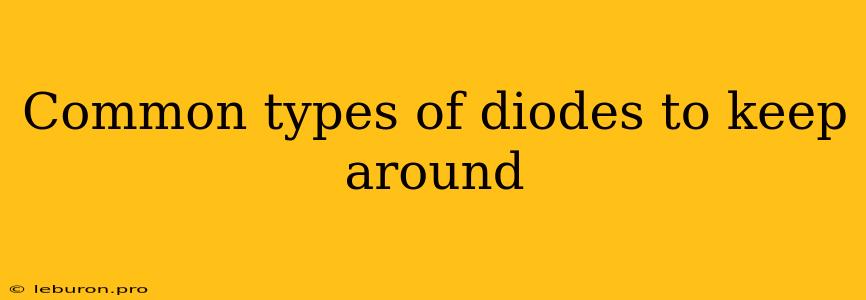Diodes are essential components in electronics, playing crucial roles in a wide range of applications. Understanding the various types of diodes available and their unique characteristics is vital for any electronics enthusiast or professional. This article will delve into some of the common types of diodes to keep around, providing insights into their functionality, applications, and why they are essential additions to any electronics toolkit. Whether you're working on simple circuits or complex projects, having the right diodes at your disposal can make a significant difference in your work.
Understanding Diode Functionality
Diodes are semiconductor devices that allow current to flow in only one direction. This unidirectional current flow characteristic is a defining feature of diodes and forms the basis for their diverse applications. The fundamental principle behind this behavior lies in the diode's internal structure.
A diode consists of a p-n junction, which is a boundary between two types of semiconductor materials: p-type and n-type. The p-type semiconductor material has an excess of holes (positive charge carriers), while the n-type material has an excess of electrons (negative charge carriers). When these materials are brought together, a depletion region forms at the junction, acting as a barrier to current flow.
Forward Bias and Reverse Bias
The key to diode functionality lies in applying voltage across the p-n junction. When the positive terminal of a voltage source is connected to the p-type material and the negative terminal to the n-type material, the diode is said to be forward biased. Under forward bias, the depletion region shrinks, allowing current to flow easily.
Conversely, when the voltage source is reversed, with the positive terminal connected to the n-type material and the negative terminal to the p-type material, the diode is reverse biased. This configuration widens the depletion region, effectively blocking current flow.
Common Types of Diodes
Now, let's explore some of the common types of diodes to keep around and their unique properties:
1. General Purpose Diodes
General purpose diodes are versatile and widely used in a variety of applications. They are often designated with a 1N prefix followed by a number, such as 1N4001, 1N4148, and 1N4007. These diodes typically have a forward voltage drop of around 0.7V and can handle currents up to 1A.
2. Rectifier Diodes
Rectifier diodes are specifically designed to convert alternating current (AC) to direct current (DC). They are commonly used in power supplies, battery chargers, and other applications requiring DC power. These diodes have higher current ratings and are often packaged in larger, more robust housings. Common examples include the 1N4001 series and the 1N5400 series.
3. Zener Diodes
Zener diodes have a unique characteristic: they exhibit a constant voltage drop (known as the Zener voltage) when reverse biased beyond a specific threshold. This property makes them ideal for voltage regulation and over-voltage protection. They come in a wide range of Zener voltages, allowing you to choose the appropriate diode for your specific application.
4. Schottky Diodes
Schottky diodes are known for their low forward voltage drop compared to standard silicon diodes. This characteristic makes them suitable for high-frequency applications where minimal power loss is desired. They are often used in switching circuits, RF amplifiers, and other high-speed applications.
5. LEDs (Light-Emitting Diodes)
LEDs are special diodes that emit light when forward biased. They are rapidly replacing traditional incandescent and fluorescent bulbs due to their energy efficiency, long lifespan, and variety of colors. LEDs are widely used in lighting, displays, and other applications where visual indication is required.
6. Photodiodes
Photodiodes are sensitive to light. When exposed to light, they generate a current proportional to the incident light intensity. They are used in light sensing applications such as light meters, optical sensors, and solar cells.
Choosing the Right Diodes
With so many types of diodes available, it's crucial to choose the right one for your specific application. Consider the following factors:
- Forward Voltage Drop: The voltage drop across a diode when forward biased. Choose a diode with a forward voltage drop suitable for your circuit.
- Current Rating: The maximum current the diode can handle without being damaged. Make sure the diode's current rating is high enough for your circuit.
- Reverse Breakdown Voltage: The maximum reverse voltage the diode can withstand before breaking down. Select a diode with a reverse breakdown voltage greater than the expected voltage in your circuit.
- Operating Frequency: Some diodes, like Schottky diodes, are designed for high-frequency operation. Consider the frequency requirements of your application when choosing a diode.
Conclusion
Diodes are ubiquitous in electronics, providing a diverse range of functionalities. From basic rectification to complex light-emitting and light-sensing applications, understanding common types of diodes to keep around is essential for any electronics enthusiast or professional. By selecting the appropriate diodes based on their characteristics and your specific needs, you can create reliable and efficient electronic circuits. Having a diverse collection of common types of diodes to keep around in your toolkit will empower you to tackle various electronics projects with confidence.
